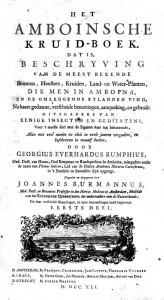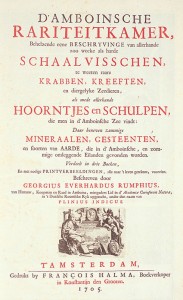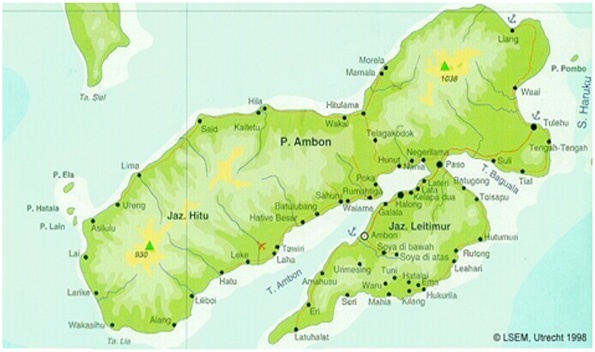On her maiden trip the boat performed well. While still in the Gulf of Ambon, a ray jumped out of the water over starboard, which according to Ambonese adat, will guarantee safe and trouble-free voyages. I didn’t see that, but the first mate did, and word quickly spread among the crew, putting smiles on their faces.
She was called Rumphius in honour and remembrance of the first naturalist of Ambon. Her hull was painted yellow and the superstructure white. It was the project boat, a floating office say, and our means of transport. She accommodated six passengers and carried a crew of seven all from Ambon, except the cook who hailed from the mountains of Tana Toraja. Built at the yard in Ambon by shipwrights from Asilulu, they had also selected and felled the trees needed for her construction on Pulau Hatala and Pulau Ela.
The other Rumphius (Georg Eberhard Rumph) was born in Hessen, Germany, in 1627, in the middle of the Thirty Years War (1618-1648) which left an indelible mark on those who survived, including Rumphius. The devastation of the country and the indiscriminate killing of its people had shown the irrelevance of “sides” and started an abhorrence of religious fanaticism and of the aristocracy who had made use of the war to improve their own position. Rumphius fled from the chaos of a country that had been raped, plundered and murdered into exhaustion. He escaped from fraudulent authority, hypocritical religion and social inequality. He possessed a just and incorruptible mind and did not suffer fools gladly. He also was modest and civil, and was able to suit himself to the temper of the Ambonese.
In 1653, at the age of 26, Rumphius arrived in Batavia (present day Jakarta). His many talents must have been noted and warmly accepted, with a bureaucratic and commercial Calvinist veneer. Apart from the obligatory ability to speak Dutch and Reformed Church membership, he could write and speak German, Portuguese and Latin. He also had military experience and had undergone engineering training, especially in the construction of redoubts.
He was soon assigned as an engineer (fabryck) to the VOC forces in Amboina (present day Ambon), where he arrived in 1654. Although quickly promoted to vaandrig – the lowest rank of commissioned officer in the VOC militia – he traded his military assignment in 1657 for a civilian one and was placed as Junior Merchant (onderkoopman) in Larike on the west coast of Ambon island.
It is here that he started his study of the flora and fauna, rocks, minerals and geology of Ambon and neighbouring islands. What started as a hobby eventually resulted in the Amboinsch Kruidboek (Herbarium Amboinense) and the Amboinsche Rariteitkamer (Amboina Curiosity Cabinet), his two most important books.
The Herbarium Amboinense is an enormous work that runs to 1,661 folio pages, in six volumes. It is a catalogue of the plants of the island of Ambon, published posthumously in 1741. It covers 1,200 species, 930 with definite species names, and another 140 identified to genus level. The book is a basis for all studies of the flora of the Moluccas and is still referred to today. Unlike the Amboina Curiosity Cabinet, the book, unfortunately, remains untranslated.
The Amboina Curiosity Cabinet was also published posthumously. The original edition appeared in 1705, in 340 folio pages, with 60 plates and five vignettes. An English version of the book is now available (Amazon and other bookshops) at a price of US$45. Published by Yale University Press, New Haven and London, and translated, edited and annotated by E.M. Beekman, who also wrote the introduction. Dr. Beekman captures the style of Rumphius beautifully and the translation is lively and easy to read. Even the description of a mollusc becomes interesting, while the accounts of local belief are truly absorbing and not only to those with a past in ethno-ichthyology.
The road to publication of these books was long and winding and full of pitfalls. The completed manuscript of the Herbarium Amboinense was sent to Jakarta for forwarding to Amsterdam in 1690. In Batavia, Governor General Johannes Camphuys had a copy made before sending it on. The ship carrying the manuscript was en route to the Netherlands when it was attacked and sunk by a French frigate.
Before news of this reached Batavia and Ambon more than two years must have passed, and an updated Camphuys copy finally arrived in Amsterdam in 1696. However, the Heeren XVII, the Board of the VOC, in an effort to protect their monopoly, decided that it should not be published. The knowledge of the natural resources of Eastern Indonesia contained therein was not allowed to be made public, and certainly not to fall into the wrong hands; the British, Portuguese, or Spanish. It became moreover clear that despite his blindness, Rumphius could continue the work on his collection. The Herbarium was finally published in 1741, nearly four decades after Rumphius’ death.
It is for the same reason that permission to publish the Amboinsche Rariteitkamer was withheld for many years.
But long before that, Rumphius had to struggle with disasters. In 1662 he had been promoted to Merchant and Head of the Hitu coast, stationed in Hila. But when, in 1670, he contracted glaucoma and lost his eyesight, the first reaction of the Governor of Ambon was to end paying his salary and request that he vacate the company house. Governor General Joan Maatsuycker, definitely an admirer and supporter of Rumphius’ scientific work, overruled this decision and transferred Rumphius to Ambon with retention of title and salary.
Helped by assistants he continued his work, but had to start writing from scratch as there was no one he could dictate Latin – yes, he intended to write the Herbarium in Latin. And then, in 1687, all illustrations were lost in the fire of Ambon. And still he continued, starting again, directing his assistants until finally in 1690 the Herbarium was completed.
Other books by Rumphius are Amboinsche Historie, and Amboinsche Lant-Beschrijvinge (a social geography). Not only is Rumphius known for his work as a botanist, but also for his major contributions to plant systematics, his skills as an ethnographer, and his frequent defence of Ambonese peoples against colonialism.
Rumphius is a perfect example of a gifted amateur naturalist studying the flora and fauna of Ambon, who became an authority. Despite the distance and the time-consuming communication, he was elected to the German scientific society Academia Naturae Curiosorum, where he was known to his fellow members as Plinius Indicus (the Pliny of the Indies).




